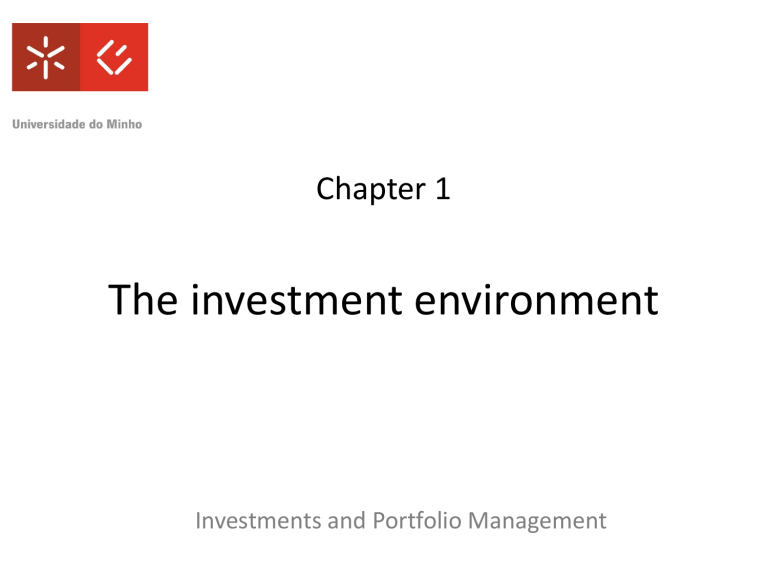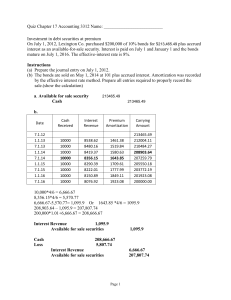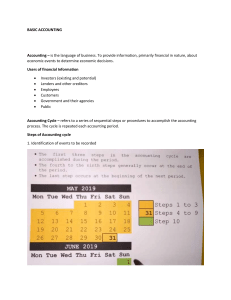
Chapter 1 The investment environment Investments and Portfolio Management Readings BKM, chapter 1 2 Investment a current commitment of resources in the expectation of obtaining future benefits 3 Real assets versus financial assets Real assets Financial assets Assets used to produce goods and services (e.g., land, buildings, machines, knowledge) Claims on real assets or the income they generate (e.g., bonds and stocks) 4 Real assets versus financial assets Investment decision Purchase of real assets Financing decision Sale of financial assets 5 Investment decision Capital budgeting decision • Decision to invest in tangible or intangible assets • Criteria for evaluating investment decisions • Risk 6 Financing decision A corporation can raise money from lenders or shareholders • If it borrows, the corporation promises to pay back the debt plus interest to the lenders • If the shareholders put up the cash, they get no fixed return, but they hold shares of stock and therefore get a fraction of future profits • The shareholders are equity investors • The choice between debt and equity financing is called the capital structure decision 7 Flow of cash between financial markets and the firm’s operations (2) Firm’s operations (a set of real assets) (3) (1) Financial manager (4) (5) Financial markets (investors holding financial assets) (1) Cash raised by selling financial assets to investors (2) Cash invested in the firm’s operations and used to purchase real assets (3) Cash generated by the firm’s operations (4) Cash reinvested (5) Cash returned to investors 8 In what do we invest in? Major classes of financial assets Debt (fixed income securities) Stocks (equity) Derivatives 9 Fixed income securities Debt securities - Payments are fixed or determined by a formula that depends on interest rates • A corporate bond typically promises that the bondholder will receive a fixed amount of interest each year • Floating rate bonds promise payments that depend on current interest rates (e.g., a bond may pay an interest rate that is fixed at 2% points above the rate paid on US Treasury Bills) • Unless the borrower goes bankrupt, the payments on these securities are certain (either fixed or determined by a formula) 10 Fixed income securities Fixed income securities come in a variety of maturities Money market debt Capital market debt Refers to securities that are short term, highly marketable, and usually of low credit risk (e.g., Treasury Bills) Includes long term bonds (such as Treasury bonds or corporate bonds) Range from safe in terms of default risk (e.g., Treasury bonds) to relatively risky (e.g., junk bonds) 11 Common stock or equity Represents ownership in a corporation • Equityholders are not promised any particular payment • Payments to stockholders – dividends – are not fixed, but depend on the success of the firm • If the firm is successful, the value of equity will increase; otherwise, it will decrease • Since the performance of equity investments is tied to the success of the firm, equity securities tend to be riskier than debt securities 12 Derivative securities Value derives from prices of other assets (e.g., stocks) Used to hedge risk E.g., options and futures 13 Derivative securities Futures An agreement made today regarding the delivery of an asset (or its cash value) at a specified delivery or maturity date for an agreed-upon price, called the futures price, to be paid at contract maturity • Long position: held by the trader who commits to purchasing the asset on the delivery date • Short position: held by the trader who commits to delivering the asset at contract maturity 14 Derivative securities Options A call option gives its holder the right to purchase an asset at a specified exercise price on or before some expiration date. A put option gives its holder the right to sell an asset at a specified exercise price on or before some expiration date. Long position on calls: higher profits when spot prices rise Long position on puts: higher profits when spot prices fall 15 Derivative securities Options Right, but not obligation, to buy or sell; option is exercised only when it is profitable The premium is the price of the option itself. Futures Obliged to make or take delivery. Long position must buy at the futures price, short position must sell at futures price Futures contracts are entered into without cost 16 Financial markets and the economy Roles of financial markets informational role consumption timing risk allocation separation of ownership and management agency problems 17 Agency problems Forms of business organization Sole proprietorship Partnership Corporation 18 Agency problems Corporation Separation of ownership and management Advantages? Disadvantages? 19 What is the goal of financial management? Maximize firm value 20 Agency problems Shareholders desire wealth maximization of the firm Do managers maximize shareholder wealth? Agency problems represent the conflict of interest between management and owners Managers, acting as agents for stockholders, may act in their own interests rather than maximizing value 21 Mechanisms to mitigate potential agency problems Compensation plans that tie the income of managers to the success of the firm Monitoring from the board of directors Monitoring by large investors and security analysts Threat of takeover for poor performers 22 Do market prices equal the fair-value estimate of a security’s expected future risky cash flows, all of the time, some of the time or none of the time? Informationally efficient 23 Can we rely on markets to allocate capital to the best uses? Allocation efficiency 24 Corporate governance and corporate ethics Markets can only be informationally efficient and allocate capital efficiently if they receive accurate information 25 Corporate governance and Financial Markets and the Economy corporate ethics Accounting Scandals WorldCom, Enron, Parmalat Role of auditors / Analyst scandals Arthur Andersen International Financial Crisis (2007/2008) Regulation Sarbanes-Oxley Act (2002) Dodd Frank Act (2010) 26 Corporate governance and corporate ethics Governance and ethics failures Erode investors’ trust Without trust additional laws and regulations are required 27 Portfolio management concepts Portfolio Collection of investment assets 28 Portfolio management concepts Asset allocation Choice among broad asset classes (e.g., money market, stocks, bonds, real estate, etc.) Security selection Choice of securities within each asset class 29 Portfolio management concepts Asset allocation Security Selection 30 Markets are competitive risk vs return risk/return tradeoff 31 Markets are competitive risk vs return How do we measure risk? What is the relationship between expected return and risk? 32 Markets are competitive risk vs return Can we reduce risk? …yes, by diversifying 33 Markets are competitive efficient markets active vs passive 34 Financial market players Lenders Borrowers Financial Intermediaries Financial Instruments 35 Financial market players Companies (net demanders of capital) Households (net suppliers of capital) Governments Financial intermediaries 36 Financial market players Financial Intermediaries Stand between security issuers and investors Bring lenders and borrowers together E.g., banks, investment companies, insurance companies 37 Financial market players Investment banking Specialize in the sale of new securities to the public, typically by underwriting the issue Commercial banking Take deposits and make loans Sell newly issued securities to public in the primary market Investors trade previously issued securities among themselves in the secondary market 38 Financial market players Venture capital (VC) Money invested to finance a new, not yet publicly traded firm. VC Investors commonly take an active role in the management of a start-up firm Private equity Investments in companies whose shares are not publicly traded in a stock market 39 Financial market players Mutual Funds Pooled, regulated, and professionally managed money open to the public. Hedge funds Pooled, private, and professionally managed money open only to institutional investors or wealthy individuals. 40 Financial market players Fintech and financial innovation “Fintech is the application of technology to provide new and improved financial services.” Thakor (2020,p.1) Technology that allows individuals to interact directly has been the source of some financial disintermediation. 41 Thakor (2020,p.1) Source: Thakor (2020) 42 Financial market players Fintech and financial innovation • Peer-to-peer lending: Links lenders and borrowers directly • Robo advice • Blockchains: Provide record of transactions securely added to a public distributed ledger. • Cryptocurrency: Payment systems that use blockchain technology. 43 The fintech industry 44







